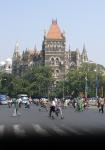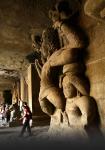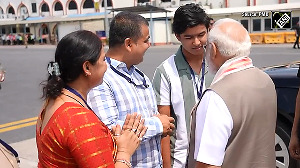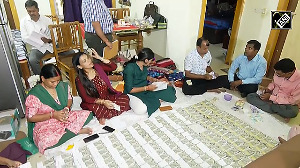From Swachh Bharat to spearheading the Make in India campaign, the PMO seems to be at the centre of all policies, writes Nivedita Mookerji.

On the evening of November 8, 2016, the sudden buzz in newsrooms was that Prime Minister Narendra Modi was going to make a major announcement.
About what?
Almost everybody, including many key government functionaries, was kept guessing.
What followed was one of the world’s largest demonetisation exercises in history. But given the fact that many senior cabinet ministers were unaware of the decision until shortly before it was announced, the announcement highlighted the worst-kept secret about this regime’s PMO: that the prime minister with his 397-member office is the only power centre.
As one Bharatiya Janata Party leader quipped, “There is only one office in the government now. That’s the Prime Minister’s Office.”
Indeed, anything from formulating economic policies to ushering in administrative reforms, from launching and overseeing the cleanliness drive under “Swachh Bharat” to spearheading the “Make in India” movement, from directions for key postings in the government to being the go-to office for business and industry, from setting the tone of the Independence Day speech to hosting marquee start-ups in mega shows, the PMO seems to be at the centre of it all.
If demonetisation had the stamp of the PMO written all over it, so did the decision to roll out the Goods and Services Tax, the biggest indirect tax reform in India’s history, from July 1, 2017, a date that most considered far too early. Demands for deferring the GST to give businesses time to ready their systems were ignored; the directive from the South Block powerhouse was to comply or else.
It is another matter that so many reports of technical glitches in filing GST returns have surfaced that the government has had to set up a committee, naming it group of ministers -- a rare beast in this regime -- to resolve them.
The power that flows from the PMO makes the denizens of this secretariat extremely powerful too.
At its head as principal secretary to the country’s 12th prime minister is Nripendra Misra, a retired civil servant from the Uttar Pradesh cadre and former telecom regulator, the appointment of whom required a speedily passed ordinance (since TRAI rules forbade officer bearers from holding posts in central or state governments after they retired).
National Security Advisor Ajit Doval, a former intelligence boffin, is another powerful advisor within the PMO.
The other top functionaries are: Additional Principal Secretary PK Mishra; Secretary Bhaskar Khulbe; two Additional Secretaries, Tarun Bajaj and AK Sharma; and five Joint Secretaries, Anurag Jain, Debashree Mukherjee, V Seshadri, Brajendra Navnit, and Gopal Baglay.
Mishra, who was part of the Modi administration in Gujarat, plays a pivotal role in all key issues of governance.
Khulbe, a West Bengal-cadre IAS, came into prominence last year when the PMO revealed the salaries of its staff. Khulbe emerged as the highest-paid PMO man with a monthly salary of Rs 2.01 lakh.
Bajaj, a Haryana-cadre IAS, was brought into PMO from the department of economic affairs, and his work area includes the all-important Aadhaar.
Sharma, a Gujarat-cadre officer, used to be known as the Vibrant Gujarat man for his role in the signature campaign under Modi’s chief ministership, and is now a point person for many industry issues.
Jain, an IIT-engineer-turned-IAS, is a Madhya Pradesh-cadre officer and seen as confidant of MP Chief Minister Shivraj Singh Chouhan. Known for his IT skills, he’s responsible for computerisation of the PMO, besides overseeing communications and skill development.
Mukherjee, an AGMUT-cadre IAS, has been at the helm of Delhi Transport Corporation and Jal Board and her current work areas cover urban development, housing, rural development, among others.
Seshadri, an Andhra-cadre IAS, mainly looks at anti-corruption issues.
Navnit, a Tamil Nadu-cadre officer who’s worked in the finance ministry earlier, is responsible for issues linked to finance, corporate affairs and Niti Aayog.
The latest entrant to this club is Baglay, an IFS and former spokesperson of the ministry of external affairs, and his responsibilities cover anything from space and defence to foreign affairs.
Modi’s all-powerful PMO has attracted attention because its uber-secretive and strongly centralised style of policy-making stands in sharp contrast to Manmohan Singh’s 10-year stint and, indeed, the first term of the National Democratic Alliance under Atal Bihari Vajpayee.
Ashok Chawla, former finance secretary (2009-11), points out that in the United Progressive Alliance government, several policies were decided by cabinet committees, groups of ministers and empowered groups of ministers. “That system has changed now.”
K M Chandrasekhar, cabinet secretary during the UPA (2007-11), said: “Manmohan Singh preferred a consensus-based approach.”
But, he says, Vajpayee, too, followed a more decentralised style.
“I was working abroad then, but I noticed in particular that the ministers I reported to from time to time -- Murasoli Maran, Arun Shourie and Arun Jaitley -- had a great deal of freedom to take decisions and this resulted in flexibility on the field,” he recalled.
The emergence of the PMO as a power centre has evolved over time, and depended on the proclivities of the incumbent in office.
Yashwant Sinha, who was finance minister and then external affairs minister in Vajpayee’s government, told Business Standard, “There’s no doubt that the PMO has emerged over the years as the most potent and powerful office in the whole government. It has expanded over time, asserting its authority on line ministries in matters of both policy and personnel.”
The early signs of the change in the PMO came way back in the '60s.
Although Jawaharlal Nehru had a lightly staffed secretariat with just one joint secretary, the structure started changing when Lal Bahadur Shastri took charge in 1964.
L K Jha, a powerful civil servant of the British era, was appointed secretary to prime minister Shastri and the number of joint secretaries increased to two.
But the real expansion of the PMO and its emergence as a power centre in its own right took place under Indira Gandhi when P N Haksar became the first principal secretary to a PM and the number of joint secretaries increased further.
“That was the start of a powerful PMO, coinciding with budgets getting bigger and the government having to deal with complex issues,” said an official who was part of the Manmohan Singh-led PMO.
“It is primarily a political office,” he added. So, if the PM is strong, so is the PMO, he added.
Commenting on the culture of the current PMO, a former minister in the Vajpayee government said, “The control over personnel has been an exercise of raw power by the PMO even earlier. But that has increased manifold now.” Today, the line ministries have almost no say in any appointment, he said.
But during Vajpayee’s time, the PM or his office rarely got into economic policy matters, he said.
“The PMO was a listener and on no occasion was any proposal made by a minister related to economic matter disregarded,” a close aide in the Vajpayee government said.
Foreign affairs, though, was occasionally a different matter.
A BJP leader said a minister accompanying Vajpayee on an official visit to another country had no idea about the speech he would deliver. “It was kept under wraps.”
On board, Vajpayee asked his minister if he had seen the speech. When the minister said “no”, Vajpayee stepped in and asked his principal secretary to show it to him. It was then that inputs were taken and the speech was modified.
Image: Prime Minister Narendra Modi meets secretaries to Government of India soon after assuming office. Photograph: PTI Photo.












